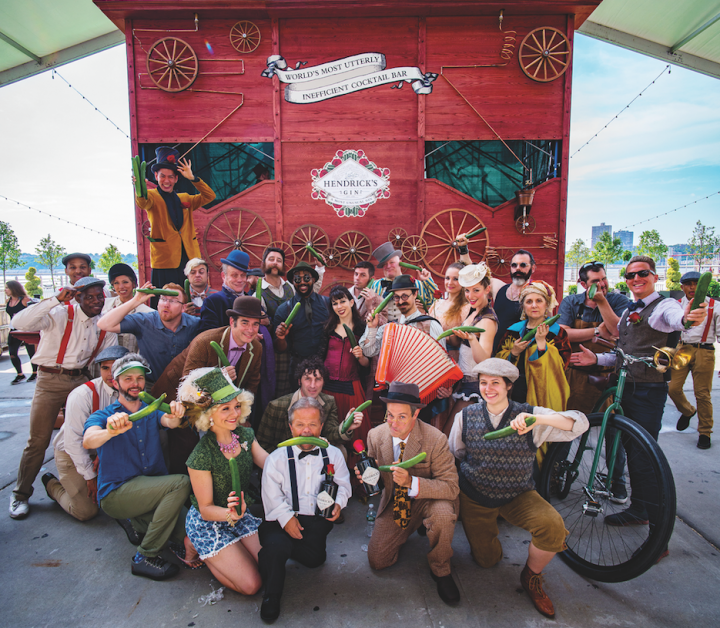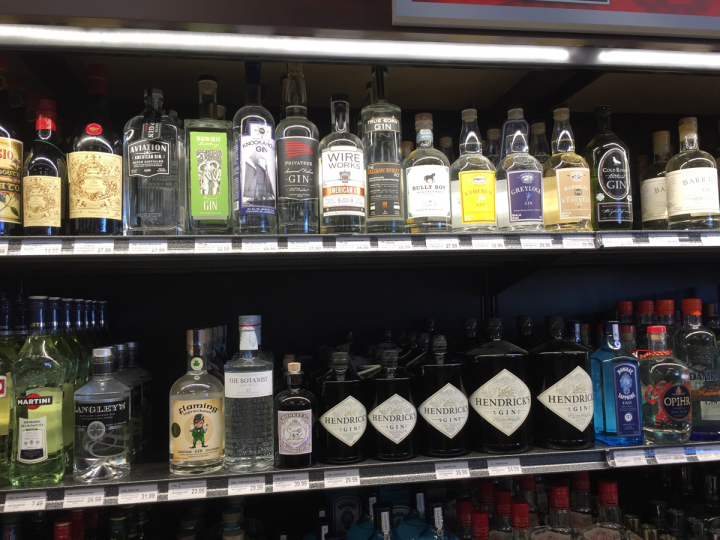
From 2008 to 2015, gin sales in the U.S. market declined significantly year over year, from 10.76 million nine-liter cases in 2008 to 9.46 million in 2015, according to Impact Databank. But in 2016, the category managed to eke out a 0.6-percent increase to 9.52 million cases, thanks largely to a few key premium labels propelling the whole category. Even as most brands in the top 10 saw declines in 2016, double-digit growth from William Grant & Sons’ Hendrick’s and Bacardi USA’s Bombay Sapphire kept the category afloat. “Premium gin is in growth mode, and Bombay Sapphire has been a large part of that momentum,” says Tom Swift, Bombay Sapphire vice president and brand managing director. “There’s been a shift from lower-priced, domestic gin brands to imported, premium and craft labels, and Bombay Sapphire is well positioned in this changing landscape.”
Sales of the top 10 gin brands indeed indicate a stark divide within the category between premium labels in the $20-to-$35 range and those in the sub-$20 range. Though Pernod Ricard’s Seagram’s ($11.99 a 750-ml.) remains the firm leader in the category, the brand saw yet another year of declines with a 2-percent dip in 2016, according to Impact Databank. Other lower-priced brands posted even larger losses, including Gordon’s ($7.99), which decreased 5.2 percent; Barton ($6.99), down 3 percent; Gilbey’s ($9.99), which dropped 5.5 percent; and Burnett’s ($10.99), which sank 4.2 percent.
Gins that fall solidly in the premium category, including storied brands with historical relevance and newer labels with craft appeal, are proving to be the category’s saving grace. Though Bombay Sapphire ($23 a 750-ml.) posted a 6.5-percent decline in 2015, the brand had a remarkable turnaround last year with 20.8-percent growth to 987,000 cases, according to Impact Databank. Hendrick’s ($34.99) once again grew by double digits in 2016, up 16.2 percent to 341,000 cases, and Tanqueray ($20.99) rounded out the premium brands that posted growth, up 1.8 percent to 1.5 million cases.

Craft Craze
Over the past decade or so, consumer habits have been shaped tremendously by the rise of mixology programs and craft spirits. “We’re seeing consumers seek out premium-quality products, driven by the craft movement, and small and local craft gins are emerging around the world as a result,” says Darius Hines, senior brand manager for Hendrick’s gin. “We maintain our status as the leader in craft gin and we’re proud of our role in catalyzing the ‘ginaissance’ ever since ushering in a new way to approach gin with our debut in 1999.”
Indeed, Hendrick’s is a pioneer in the artisanal spirits movement, making way for a whole new wave of craft gins to enter the market. “The hottest trend in spirits sales as a whole is novelty—consumers are disproportionately drawn to new products,” says Tommy Applebaum, co-owner and CEO of St. Paul, Minnesota–based retailer Big Top Liquors. “With gin, consumers increasingly prefer craft brands like Plymouth, Prairie and Hendrick’s.” Hendrick’s is a top-seller at Big Top, retailing at $22.99 a 750-ml.—right in line with the pricing sweet spot at the store, according to Applebaum.
At Boston-area retailer Kappy’s Fine Wine & Spirits, the popular price range for gin is slightly higher at $27 to $35, according to owner Bob Selby. “Overall, Hendrick’s is a top performer for us with all three large-format sizes—$29.99 a 750-ml., $39.99 a 1-liter and $54.99 a 1.75-liter—in our top 10 best-sellers,” he says. Large formats of Tanqueray ($27.99 a 1.75-liter) and Bombay Sapphire ($32.99) also do well at Kappy’s. Selby adds that smaller boutique gin labels are doing increasingly well at his store. “We’ve had great success in the last few years with brands like The Botanist at $29.99 a 750-ml., Grays Peak at $15.99 and Plymouth at $33.99,” he adds.
At Buster’s Liquors & Wines in Memphis, Tennessee, Hendrick’s ($35.99 at 750-ml.), Bombay Sapphire ($29.99 a 1.75-liter) and Tanqueray ($33.99) are best-sellers, but president and co-owner Josh Hammond notes that newer brands are making their mark, including Uncle Val’s ($34.99 a 750-ml.), Sipsmith ($38.99), Seersucker ($26.99) and Monkey 47 ($51.99 a 375-ml.). Imported and domestic craft brands like these make up a smaller portion of the overall category but are growing rapidly. Other top imported gins—including Proximo Spirits’ Boodles, Kindred Spirits’ Martin Miller’s, Deutsch Family Wine and Spirits’ Citadelle, Pernod Ricard’s Plymouth and Prestige Wine & Spirits Group’s Greenall’s—posted significant gains in 2016, according to Impact Databank.
Although Pernod Ricard’s Beefeater was down 2.3 percent to 472,000 cases in 2016, Plymouth was up 7 percent to 32,000 cases. The company acquired the Monkey 47 brand in 2016 to grow its gin presence even further. “The super-premium category has seen an influx of international craft brands trying to push the boundaries of what a gin can be,” says Jennifer Schwartz, manager of new brand strategy and experimentation at Pernod Ricard. “We think we have something special with Monkey 47, which is a small-batch, handcrafted gin from Germany’s Black Forest.”
In February, Campari America acquired Bulldog gin ($24.99 a 750-ml.), which first launched in the U.S. market in 2007. The brand sold around 150,000 cases in 2016, according to Shanken News Daily. “When Bulldog was developed, the majority of well-known gin brands promoted a strong juniper flavor,” says Christine Moll, Campari America’s category managing director for gin. “Bulldog’s founder saw the opportunity to create a premium, versatile gin with a citrus-forward flavor profile that would appeal directly to the modern consumer.”
With imported craft brands paving the way, a growing number of locally distilled gins have entered the market. St. George Spirits in Alameda, California, released its lineup of gins—Terroir, Botanivore and Dry Rye, each around $35 a 750-ml.—in 2011. “Today’s consumers are interested in expanding their drinking horizons,” says Steve Ciavola, vice president of sales for St. George. “They’re more adventurous and want new experiences. Our gins couldn’t have been introduced at a better time.”

Experimental Expressions
Beyond seeking out craft and locally produced items, consumers are simply willing to spend more on a high-quality, interesting product, says Campari’s Moll, noting that millennial drinkers are at the forefront of this trend. Swift of Bombay Sapphire adds that these younger drinkers aren’t following the “traditional trade-up mentality.” “This next generation of gin consumers is entering the category in the premium segment and then navigating among brands with different taste profiles, rather than starting with lower priced brands and graduating up from there,” he explains.
Ciavola notes that since there are so many high-quality, premium gin brands on the market today, finding ways to stand apart from other labels is important. “Uniqueness is trending in the category,” he says. “Consumers are moving away from the same old, same old and are looking for gins that offer something different and unique.” St. George’s gins each focus on a different combination of botanicals, most of which are native to California.
“Gin is a highly experimental category, with consumers trying new or exotic brands and discovering different flavor profiles that they prefer over others,” says Michael Lowry, senior manager of distilled spirits for Potomac, Maryland–based national retailer Total Wine & More. He points to the rising popularity of local gins like Bluecoat in Philadelphia and Green Hat in Washington, D.C., for their unique flavor profiles and production methods. “Bluecoat is a highly aromatic gin in a striking blue bottle, and Green Hat is herbaceous and created in small batches in a copper pot still,” he says. Both gins are in the premium $25-to-$35 a 750-ml. range.

Hines of Hendrick’s notes that the consumer culture of experimentation has been a boon to the brand. “We’re noticing that newer gin drinkers aren’t afraid to experiment with different flavor profiles, and our combination of cucumber and rose petal really resonates with this audience,” he says.
For traditional London dry–style gins like Bombay and Tanqueray, reaching this consumer base has meant releasing new variants to keep experimental drinkers interested. Bombay has seen success with its Bombay Sapphire East extension, introduced in 2011, which is infused with lemongrass and black pepper. “With three distinct gins in our portfolio now—Bombay Original, Bombay Sapphire and Bombay Sapphire East—we are in a great place to appeal to the growing number of discerning gin consumers,” Swift says.
Selby of Kappy’s has been impressed with the steady innovation he’s seen coming from these big players. “Top producers are experimenting and reissuing special editions like Beefeater Burrough’s Reserve and Tanqueray Malacca,” he notes. Beefeater released a second edition of the super-premium Burrough’s Reserve ($69.99 a 750-ml.) last year, while Tanqueray’s most recent extension is its juniper-forward Bloomsbury ($32.99), also launched in 2016.

Trade Trust
Today’s consumers are drinking gin predominantly in cocktails, with classic drinks like the Gin and Tonic and the Negroni experiencing renewed interest nationwide. “Gin is on every cocktail menu now,” Total Wine’s Lowry says. “A well-made gin cocktail is one of the primary measures of a good mixologist.”
To stay relevant and on top of trends, leading gin brands are focusing on developing strong relationships with bartenders and on-premise accounts, as well as working with corporate mixologists and brand ambassadors to develop new cocktail recipes. “As more consumers enter the premium gin category, we see tremendous opportunity to drive education on the versatility of Bombay gins in cocktails,” Swift says. “Our Most Imaginative Bartender competition, which is entering its 11th year, has continued to support up-and-coming mixology talent, showcasing bartenders from across North America.” Last year, Boston-based mixologist Schuyler Hunton won the competition with his Breakfast in Bombay cocktail, featuring Bombay Sapphire, lemon juice, egg white, and house-made grapefruit and Earl Grey tea oleo-saccharum.
“Building relationships with bartenders and educating them on Bulldog is a major part of our marketing strategy,” Campari’s Moll says. “Bartenders love versatile spirits and gin, with its unique flavor profile, is a great mixable spirit, whether it’s in a simple Gin and Tonic or something more sophisticated.”

Hines notes that focusing on the on-premise has helped Hendrick’s become a household name. “Hendrick’s gin’s success and continued growth can be credited to the strong trade focus we’ve fostered as one of the pioneers of the craft gin movement and the resulting advocacy these trade partners have built with consumers, who trust their expertise,” he says. Hendrick’s is indeed closely tied with the craft mixology scene, featured in such high-end cocktails as the Silver Springs ($16) at New York City craft cocktail bar PDT. The drink, created by general manager Jeff Bell and bartender A-K Hada, features Hendrick’s, Kamoizumi Umeshu sake, Chareau aloe liqueur, and muddled cucumber and shiso leaf.
Cucumber ties heavily into Hendrick’s marketing campaigns. Last year the brand announced its “whimsical takeover” of National Cucumber Day in June with a series of events including The Cucumber Festival of Wonder in New York City. At this celebration, the gin’s natural pairing with cucumber was showcased in a range of cocktails created by brand ambassador Jim Ryan. His Cucumber Basil Smash featured the gin with lemon juice, simple syrup, and fresh cucumber and basil.
As a category so clearly bolstered by premium and boutique brands, suppliers are optimistic that new entrants will only help future gin sales. “The level of competition is rising quickly, especially on a local level as more distilleries open,” St. George’s Ciavola says. “But we welcome this. Competition makes us better.”
Campari’s Moll shares this sentiment, adding that competition is bringing excitement back to gin. “As the saying goes, a rising tide raises all ships,” she says. “We’re happy to see so many spirits companies and purveyors engaging in the category.”